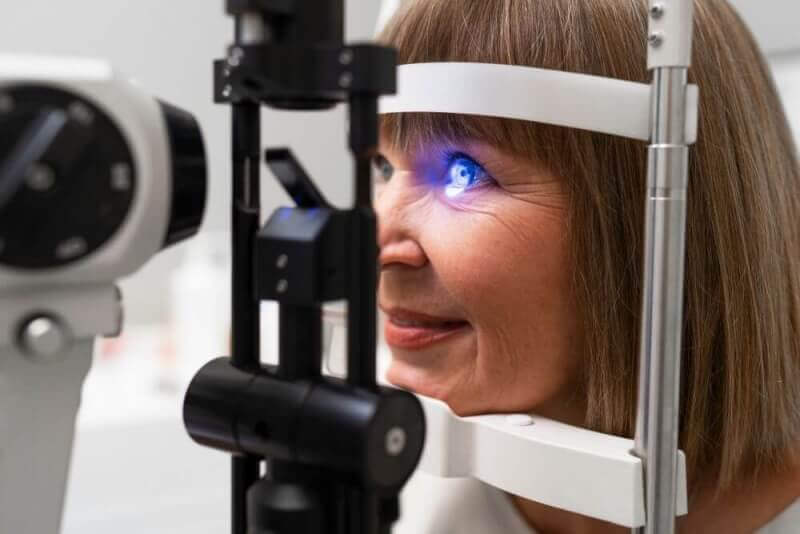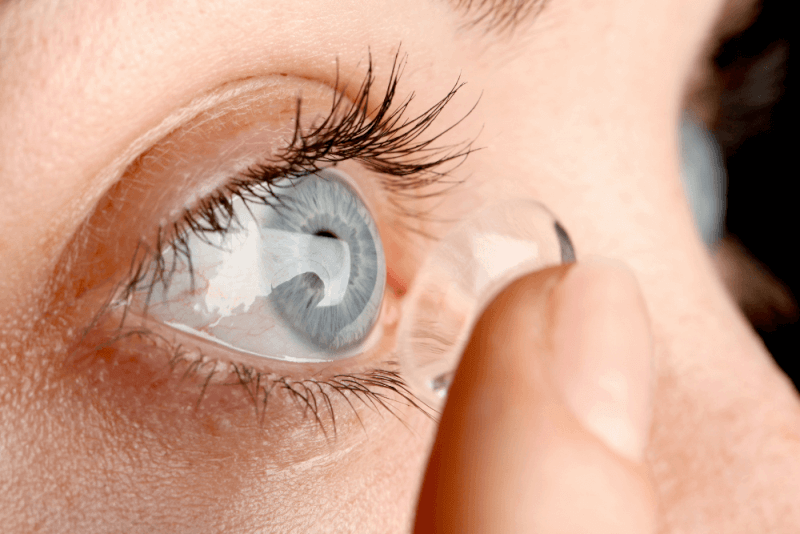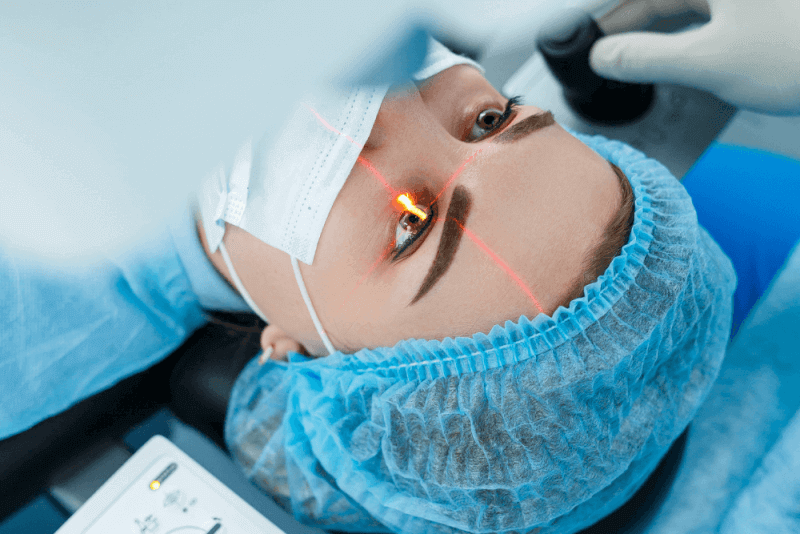What is myopia?
It is a common vision problem in which nearby objects can be seen clearly but distant objects are blurred. In general, it is a condition that occurs when the shape of the eye is distorted or when the rays are refracted incorrectly in case of deformity in certain parts of the eye. In this case, the rays that should be focused on the retina at the back of the eye are focused in front of the retina. Myopia, which develops in childhood and adolescence, stabilizes between the ages of 20 and 40. Myopia, which has a genetic tendency, is diagnosed with a basic eye examination.
Diagnostic criteria for myopia
Myopia is diagnosed with a basic eye examination. They also ask about the patients' medical history and medications. Among the tests used in myopia diagnosis are the following.
Visual acuity test
It is a test to check how sharp vision is for distant objects. To do this, one eye is closed and with the other eye letters and symbols of different sizes are read. The same procedure is then applied to the other eye. For children who cannot read, this test is done with various graphics.
Foroptor
It is a test to determine the prescription needed to treat the vision problem. In this test, different lenses that correct vision are tried on by the patient.
Other eye health tests
Other tests to determine eye health include the following.
- Condition of the cornea, pupil, lens and eyelids
- Reaction to light
- Intraocular pressure
- Eye movement
- Environmental opinion
Inner eye examination
Special lenses with light are used to examine the condition of the retina and optic nerve. Drops are used for enlargement of the retina. There is light sensitivity for a few hours after the drop application.
Causes of myopia
Myopia is a health problem caused by refractive errors. The shape or condition of the cornea causes the light entering the eye to be misfocused. This leads to the appearance of myopia.
It is a condition caused by the eye being too long or oval shaped. In addition, a very steep corneal curve can also cause myopia. All these changes in eye anatomy cause the rays to focus in front of the retina. This causes the signals transmitted to the brain to be blurred. Other fracture errors include the following.
- Hyperopia: occurs when the eyeball is shorter than a normal eye or the corneal curvature is less. Some patients can see more distant objects clearly, while objects in the middle distance are blurred.
- Astigmatism: a condition in which the cornea or lens is curved more steeply in one direction than the other. In astigmatism, vision is impaired at all distances.
Symptoms of myopia
Symptoms of myopia include the following.
- Eye strain
- Blurred vision when looking at distant objects
- Headache
- Squinting the eyelids or closing the eye completely for clear vision
Among the symptoms of myopia in children, the following symptoms can also be seen.
- They have difficulty seeing the boards or projections in their classrooms
In younger children, vision may not be impaired. Instead, behaviors indicative of visual impairment appear. These behaviors include the following.
- Sitting close to the TV
- Persistent strabismus
- Frequent rubbing of the eyes
- Pretending not to be aware of distant objects
- Excessive blinking
Adults with myopia may have difficulty reading street signs. They may also have difficulty with blurred vision when driving at night. This condition is called myopsia.
Myopia treatment methods
In the treatment of myopia, lenses that correct refraction or surgeries that correct refraction are used. Treatment of myopia also includes managing various complications, including glaucoma, cataracts and retinal detachment.
Prescription lenses
Wearing corrective lenses allows correction of refraction caused by the increased curvature of the cornea or the increased length of the eye.
The use of glasses is the most reliable way to clarify the blurred image caused by myopia. Spectacle lenses also provide correction of nearsightedness and astigmatism. Contact lenses can also correct multiple refractive errors.
Myopia laser treatment
Refractive surgery reduces the need for glasses and lenses. Eye surgeons use laser technology to reshape the eye. Myopic patients may continue to wear glasses after surgery. The techniques used in the treatment of myopia include the following.
- Laser-assisted in situ keratomileusis (LASIK): applies a thin, hinged flap to the cornea. A laser is then used to remove corneal tissue to flatten the domed shape of the cornea. Recovery after LASIK surgery is faster and causes less discomfort than other surgical methods.
- Laser-assisted subepithelial keratectomy (LASEK): in this procedure, an ultra-thin flap is created in the outer protective covering of the cornea. Afterwards, a laser is used to reshape the cornea.
- Photorefractive keratectomy (PRK): complete removal of the epithelial layer of the cornea and subsequent reshaping of the cornea. In this respect, it is similar to the LASEK method. After this operation, a protective contact lens is worn. This lens covers the cornea until the epithelial layer regrows to match the new shape of the cornea.
Process after myopia laser treatment
Among the points that patients should pay attention to after laser treatment are the following.
- The eyes do not need to be covered with a bandage after surgery.
- After surgery, it is necessary to visit the doctor at certain intervals.
- After the surgery, the prescribed medications should be used regularly.
- A slight stinging and watering for a few hours after surgery is normal.
- Normal life can be resumed 24 hours after surgery.
Myopic astigmatism
Myopic astigmatism, a type of astigmatism, can be seen in all ages and genders. Refractive disorders can often be seen in combination with different types of refractive disorders. The most common associated visual defects are myopia, hyperopia and astigmatism.
Astigmatism is the blurring of the image because the shape of the cornea is not perfectly round. Myopia is the focusing of light in front of the retina for various reasons. Myopic astigmatism is divided into two different types.
- In simple myopic astigmatism, one of the axes of the eye focuses on the retina while the other axis focuses in front of the retina.
- In compound myopic astigmatism, the focus is on the front of the retina in both axes. People with compound myopic astigmatism have blurred vision regardless of whether the object is near or far.
Symptoms of myopic astigmatism
The symptoms of myopic astigmatism are a combination of symptoms of both myopia and astigmatism. For this reason, the following are among the symptoms seen.
- Blurred image regardless of distance
- Burning sensation in the eyes
- Light sensitivity
- Pain in the forehead and eyes after reading
- Eye strain
Myopic eye exercises
Myopic eye exercises help to keep the eyes moist, maintain muscle flexibility and preserve eye roundness. Although eye exercises do not cure myopia naturally, they slow down the increase in myopia. Before starting eye exercises, it is recommended to consult a specialist in this field and start the exercises if the specialist approves.
Closing the eyes with the palms of the hands
The steps of this exercise to reduce stimuli to the eyes and brain are as follows.
- After sitting comfortably on a chair, hands are rubbed until warm.
- Close the eyes and press the palms of the hands lightly over the eyes. At this stage, excessive pressure on the eye walls should be avoided and the nose is exposed.
- Light should be prevented from entering the eyes in any way. At this stage one should imagine a total darkness and focus on this darkness.
- With eyes closed, imagine a calming landscape and take deep breaths at the same time.
- The palms are withdrawn from the eyes when he sees nothing but darkness.
- The process of closing the eyes of the palms should be done for more than 3 minutes.
Eye massage
The steps of this massage to increase blood circulation around the eyes and face are as follows.
- Take 2 towels and soak one in warm water and the other in cold water. First, a warm towel is placed over the face to cover the eyes. After waiting for 3 minutes, remove the warm towel and put on a cold towel. Different temperatures applied to the face will cause the blood vessels to contract and expand. This will increase blood flow around the eye.
- Then rub the neck, forehead and cheeks with a warm towel. Using fingertips, gently massage the forehead and closed eyes.
- Wash hands thoroughly, close eyes and massage with fingers in a circular motion for 1 to 2 minutes. During the massage application, it is necessary to make sure that light pressure is applied to the eyes.
Eye exercises
The stages of these exercises, which strengthen the level of focusing the eyes near and far, are as follows.
- Stand in front of a blank wall or sit on a chair. Then the thumb is held about 25 cm in front of the face and the finger is focused on. It can also focus on an object 1.5 to 3 m away for 10 to 15 seconds. The next step is to focus on another object 3-6 m away without moving the head. This focusing time should not exceed 10 to 15 seconds.
- In the final stage, refocus the thumb for 15 seconds and repeat this exercise 5 times.
Zoom in and out exercises
To focus on an object at different distances, it is necessary to keep the lenses moving continuously. The stages of exercise for this are as follows.
- Sit on a chair in a comfortable position.
- Raise the hand with the thumb up.
- Focus on the thumb and first zoom in so that the finger is 7 to 8 centimeters from the face.
- The arm is then fully extended forward.
- It will be enough to repeat the exercise 3 times a week
Drawing the number 8 with the eyes
The steps of this exercise to control eye movements are as follows
- A large figure 8 is imagined on the floor at a distance of about 3 m.
- It is then slowly drawn with 8 eyes.
- The drawing of the number 8 should be repeated once from the left side and then from the right side.
Eye exercises with the eye by looking in different directions
Moving the eyes in different directions is extremely beneficial for strengthening the eye muscles. The steps to be taken for this include the following.
- Stand upright and look straight ahead.
- Before moving the head, look to the left and focus on the object seen.
- Then the head is not moved and the eyes are moved to the right side. This movement is performed in 3 sets after resting to be repeated 5 times.
- The next step is to look downwards without further movement and focus on the object seen below. The eyes are then shifted upwards. This movement should be repeated 3 times.
- The last movement of the exercise is to look straight ahead without moving the head. The gaze is then shifted downwards and to the left. After focusing on what is seen on the left side, the eyes are moved diagonally, looking up and to the right and again focusing on the object seen. This movement should be repeated 5 times. After each movement is finished, gaze in the opposite direction and continue the sequence.
Types of myopia
Simple myopia
This type of myopia is generally seen in children between the ages of 6 and 12. It is caused by both genetic predisposition and environmental factors. The degree of myopia is usually less than 6 and increases for the first 3 to 4 years and then stabilizes. Although it is one of the most common types of myopia, doing work that requires attention at close range usually causes the degree to increase.
Night myopia
Although there is no problem with vision during the day or in lighted environments, the deterioration of image quality at night or in dimly lit environments is called nocturnal myopia. Although it is one of the common types of myopia, it is especially problematic when driving at night. For this reason, patients who have to drive at night should definitely wear glasses.
False myopia
It is a type of myopia that occurs temporarily as a result of sudden spasm in the eye or in the muscles around the eye.
Axial myopia
It is a type of myopia caused by an increase in the anterior and posterior diameter of the eyeball. Myopia occurs because the eyeball is longer than the focusing power of the eye. It is the most common type of myopia seen in childhood. A long eyeball causes blurred vision, where light is focused in front of the retina instead of directly on the retina.
Axial myopia, which usually starts during the school years, becomes fixed by the time the patient reaches his/her mid-twenties. While mild and moderate disorders usually do not cause any eye complications, people with advanced degrees may experience eye-related complications.
Secondary myopia
Myopia caused by medications used in the treatment of different diseases causing changes in the structure of the lens is called secondary myopia.
Curvature myopia
It is a type of myopia caused by the curve of the cornea or the lens in the front part of the eyeball increasing over time. These changes cause light to refract more. It is especially seen due to diseases such as corneal ectasia and keratoconus.
Refractive myopia
It is a type of myopia seen in the initial stage of cataracts caused by various metabolic diseases such as diabetes. Because at this stage, the refractive rate of the lens of the eye may increase.
Axis myopia
Although all structures of the eye are normal, the anterior and posterior length of the eye is outside the normal standards. Although there are no factors that cause visual defects in the eye, light is focused in front of the retina due to the long eyeball.
Congenital myopia
It is a type of myopia that usually affects children aged 2 to 3 years. Children at this age show symptoms such as not being interested in distant objects or not being interested in objects that are shown. In addition to having a progressive characteristic, it is usually a high-grade type of myopia.
Pathological myopia
It is usually a type of myopia of grade 7 and above. The nasal area of the retina is closed due to this change, as the anterior and posterior fronts of the eye become too elongated. As a result of this change, the vessels curve and protrude from the optic nerves. Pathology myopia causes degenerative changes, especially in the back of the eye.







